
Garfield Park is a 184-acre (0.74 km2) urban park located in the East Garfield Park neighborhood on Chicago's West Side. It was designed as a pleasure ground by William LeBaron Jenney in the 1870s and is the oldest of the three large original Chicago West Side parks. It is home to the Garfield Park Conservatory, one of the largest plant conservatories in the United States. It is also the park furthest west in the Chicago park and boulevard system.

The Avery Coonley House, also known as the Coonley House or Coonley Estate was designed by architect Frank Lloyd Wright. Constructed 1908–12, this is a residential estate of several buildings built on the banks of the Des Plaines River in Riverside, Illinois, a suburb of Chicago. It is itself a National Historic Landmark and is included in another National Historic Landmark, the Riverside Historic District.

Taliesin, sometimes known as Taliesin East, Taliesin Spring Green, or Taliesin North after 1937, is a property located 2.5 miles (4.0 km) south of the village of Spring Green, Wisconsin, United States. It was the estate of American architect Frank Lloyd Wright and an extended exemplar of the Prairie School of architecture. The 600-acre (240 ha) property was developed on land that originally belonged to Wright's maternal family.

Fair Lane was the estate of Ford Motor Company founder Henry Ford and his wife, Clara Ford, in Dearborn, Michigan, in the United States. It was named after an area in Cork in Ireland where Ford's adoptive grandfather, Patrick Ahern, was born. The 1,300-acre (530 ha) estate along the River Rouge included a large limestone house, an electrical power plant on the dammed river, a greenhouse, a boathouse, riding stables, a children's playhouse, a treehouse, and extensive landmark gardens designed by Chicago landscape architect Jens Jensen.

Jens Jensen was a Danish-American landscape architect.

George Washington Maher was an American architect during the first quarter of the 20th century. He is considered part of the Prairie School-style and was known for blending traditional architecture with the Arts & Crafts-style.
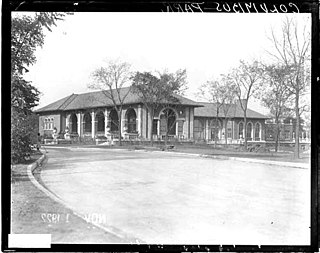
Columbus Park is a 135-acre (55 ha) park located on the far West Side of Chicago, Illinois in the Austin neighborhood. It is considered the finest work by landscape architect Jens Jensen and was consequently named a National Historic Landmark in 2003.
John Shellette Van Bergen was an American architect born in Oak Park, Illinois. Van Bergen started his architectural career as an apprentice draftsman in 1907. In 1909 he went to work for Frank Lloyd Wright at his studio in Oak Park. At Wright's studio he did working drawings for and supervised the Robie House and the Mrs. Thomas Gale House. Van Bergen designed prairie style homes in the Chicago area, mostly in the suburbs of Oak Park and River Forest. His home designs are recognized as excellent examples of Prairie style architecture and several are listed as local landmarks. A few of his homes are listed on the U.S. National Register of Historic Places.

Judson Studios is a fine arts studio specializing in stained glass located in the Highland Park section of northeast Los Angeles. The stained glass studio was founded in the Mott Alley section of downtown Los Angeles in the mid-1890s by English-born artist William Lees Judson and his three sons. It moved to its current location in 1920 and remains in operation as a family-run business. The Judson Studios building was named a Historic-Cultural Landmark by the City of Los Angeles in 1969 and listed in the National Register of Historic Places in 1999.
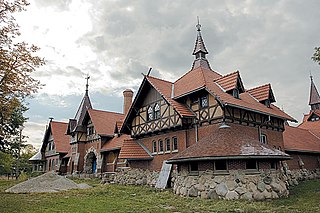
Humboldt Park is a 207-acre (84 ha) park located at 1400 North Sacramento Avenue on the West Side of Chicago, Illinois. It opened in 1877, and is one of the largest parks on the West Side. The park's designers include William Le Baron Jenney, and Jens Jensen.
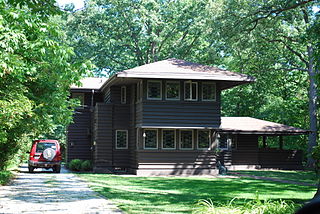
The George Madison Millard House, is a Frank Lloyd Wright designed Prairie School home that was constructed in Highland Park, Illinois, United States in 1906. It was the first of two houses that Wright would design for the Millards.
Lawrence Buck (1865—1929) was a successful and influential Chicago area residential and commercial architect, artist and landscape painter, associated with the Prairie School and the American Arts and Crafts Movement.

The Guyon Hotel is a historic former hotel in Chicago, Illinois. The hotel was designed by Jensen J. Jensen - no relation to the famous landscape architect Jens Jensen - in 1927 and was built in red and cream brick with arched windows on two floors and exquisite, detailed terra cotta ornaments typical of Jensen's work. It was built at a cost of $1,650,000 by J. Louis Guyon, a French-Canadian nightclub owner and dance instructor.

The Sylvester Millard House is a historic log house in Highland Park, Illinois, United States. Built in 1893 for a Chicago lawyer, the house was designed by William W. Boyington and remained in the family until the 1990s.
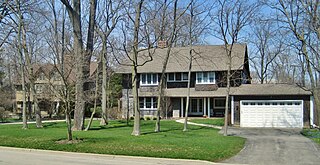
The Hazel Avenue/Prospect Avenue Historic District is a historic area of Highland Park, Illinois, United States. It was home to some of Highland Park's most notable residents, including telephone inventor Elisha Gray.
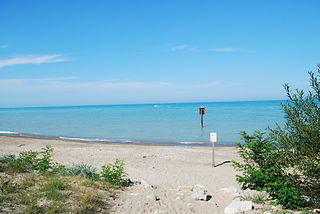
Rosewood Park is a historic park on Roger Williams Avenue in Highland Park, Illinois. The park is the former site of the Julius Rosenwald Estate, which was built circa 1910 for businessman Julius Rosenwald. Landscape architect Jens Jensen designed the estate's grounds, which he also used as a studio; these became the modern park after the home's removal. The park includes a beach on Lake Michigan, the North Shore Sanitary District Tower (closed), an empty stone pool and artificial stream, and a walking path that leads to a bridge over a ravine. Jensen also planted wildflowers in the park, which still bloom annually in spring.
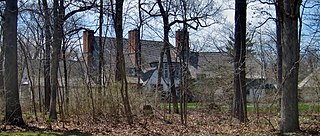
The Harold Florsheim House is a historic house at 650 Sheridan Road in Highland Park, Illinois. The house was built in 1925–28 for businessman Harold M. Florsheim, who later became the president of Florsheim Shoes. Chicago architect Ernest Grunsfeld, who went on to design the Adler Planetarium, designed the house in the French Chateau style. The house includes a gable above the entrance, a multi-story three-sided bay window, casement windows, and a hip roof broken by dormers. Landscape architect Jens Jensen designed the house's grounds, making use of a ravine on the property to instill a sense of privacy.

The Ernest Loeb House is a historic house at 1425 Waverly Road in Highland Park, Illinois. The house was built in 1930 for Ernest Loeb. Architect Arthur Heun, who also designed a nearby home for Loeb's brother Allan, designed the house in the Georgian Revival style. The house's design includes a brick exterior, a fanlight above the front door, a pediment at the roofline above the entrance, and a hip roof. Landscape architect Jens Jensen designed the house's grounds, which feature characteristic elements of Jensen's work such as curved paths and native plants.
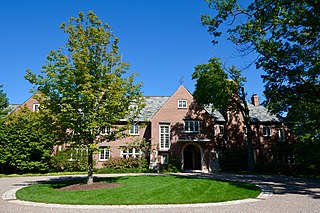
The A. G. Becker Property is a historic estate at 405 Sheridan Road in Highland Park, Illinois. The estate was built in 1921 for businessman A. G. Becker. Architect Howard Van Doren Shaw designed the estate's brick Tudor Revival house, which has been modified significantly since its construction. Landscape architect Jens Jensen designed the estate's grounds, which include typical elements of Jensen's such as native plants and decorative rockwork. The grounds also include one of the few surviving Jensen-designed meadows, a once-common feature of his work that was often lost to land divisions and development.

Mahoney Park is a public park on Sheridan Road in the southeast corner of Kenilworth, Illinois. The park opened in 1933 on land donated to the village by the Mahoney family, who required that the land become a park as a condition of their donation. Landscape architect Jens Jensen designed the park; while Jensen designed many private estates in the 1920s, his 1930s work was less prolific and focused on projects with personal significance to him. Jensen's design for the park was inspired by the Prairie School movement and includes curving paths, wildflowers, islands of shrubbery and trees, bird baths, and seven council rings. The park is the only remaining small park designed by Jensen and is a rare intact example of his work in north suburban Chicago, as many of his larger works were later subdivided.



















